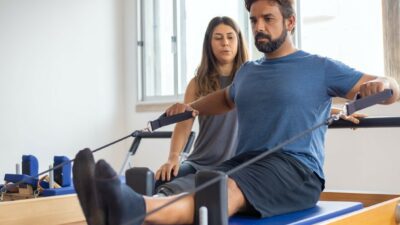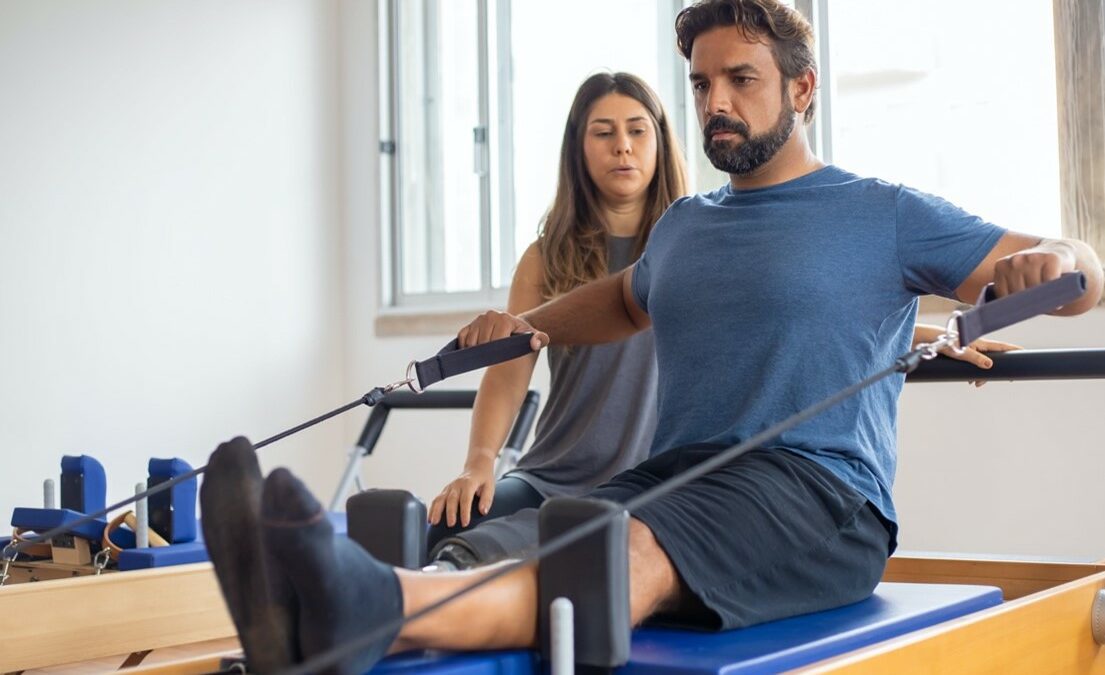



Extract Adapted from:
Pilates for Rehabilitation by Samantha Wood
Pilates is a great tool to assist or even enhance a physiotherapy program when someone is recovering from an injury. Strengthening the deepest muscles of the core, optimizing alignment, and creating correct movement patterns, can also help to prevent the reaggravation of those injuries and the development of new ones. Many trainers seek a system that can take patients from the early stages of rehabilitation to the long-term goal of an efficiently functioning body and Pilates is one of those systems. Here are some of the benefits of Pilates for rehabilitation and injury prevention.
Benefits of Pilates on Core
The core is often referred to as the powerhouse or the internal support system in Pilates and as the local muscle system in the rehabilitation realm. Whichever term you prefer, we are talking about the deepest intrinsic muscles of the trunk that attach directly to the spine and offer stabilization. The importance of these deep muscles in rehabilitation, primarily for patients with lumbar pathologies, has been well-established both in the literature and in clinical practice. Whether you go to a private stem cell therapy clinic or visit your local hospital, experts there will underline this aspect.
What makes Pilates beneficial for core muscles is that it primarily focuses on the centre or core muscles which leads to exercises that emphasize both stability and mobility. Another benefit of Pilates is that most exercises work muscles both statically and dynamically.
Pilates Emphasize Both Stability and Mobility
A strong, optimally functioning body must be both stable and mobile. Adequate stabilization proximally enables us to attain optimal function distally. For example, a tennis player must have proximal strength and stability of his shoulder girdle and tremendous mobility in the arm to be able to efficiently hit the ball. If the shoulder is weak or unstable it is likely that an injury will occur over time. The common tennis injury which we know as ‘tennis elbow’ is often caused by repetitive motion of the forearm muscles, which attach to the outside of the elbow and muscles and tendons become sore from excessive strain. One of the ways we treat this is to strengthen the muscles of the arm, shoulder, and upper back to help take stress off of the elbow. This can be achieved by Pilates.
Some of the exercises focus on stability (front support), some focus on mobility (kneeling arm circles) in Pilates.
Thus, Pilates emphasizes both stability and mobility, allowing us to achieve optimal performance and helping to prevent injuries.
Pilates Exercises are Functional
When functional movements such as walking or running are performed, a single muscle does not work in isolation. These movements involve multiple muscles while some working concentrically, some eccentrically, and some isometrically in a coordinated way to achieve a certain action. Many Pilates exercises simulate everyday activities, which makes them perfect for injury rehab and prevention.
The concept of functionality in rehab also means we must look at what the client needs to make the exercises task specific. If your client is a rugby player needing strength or a desk jockey needing postural exercises to reverse the effects of sitting all day, the huge repertoire of Pilates exercises provides endless options to allow trainers to make the exercises appropriate for all types of clients. If the exercise does not exist in the repertoire, we can design an appropriate exercise, using the equipment to either provide support or create additional challenge.
Adaptability of Pilates to Many Different Patients
Pilates is versatile and adaptable, and appropriate for just about any patient or client. It offers wide range of solutions to those with restricted mobility and to elite athletes. The Pilates system facilitates a positive movement experience no matter the patient’s level, size, or limitations. The equipment also allows trainers to select or create the appropriate exercises based on patient’s condition. It is as motivating for men as for women and it is safe for all ages when used correctly. Diagnoses such as low back pain, arthritis, post-motor vehicle accident pain, total joint replacement, rotator cuff repair and many more can benefit from Pilates
Pilates Is a Mind-Body Form of Conditioning
Patients can reach far greater potential when mental conditioning is integrated into the motor learning and neuromuscular re-education process. This is easily achieved by following the guiding principles of Pilates presented. It is widely accepted that some versions of these principles are what make Pilates a mind–body form of conditioning rather than only a physical process. As stated by physiotherapist, occupational therapist, and Pilates instructor trainer Wayne Seeto (1), “Mindful movement and proper diaphragmatic breathing provide kinaesthetic awareness and a stable base from which to move. The idea of focusing the mind on what the body is doing can afford profound benefits.
References